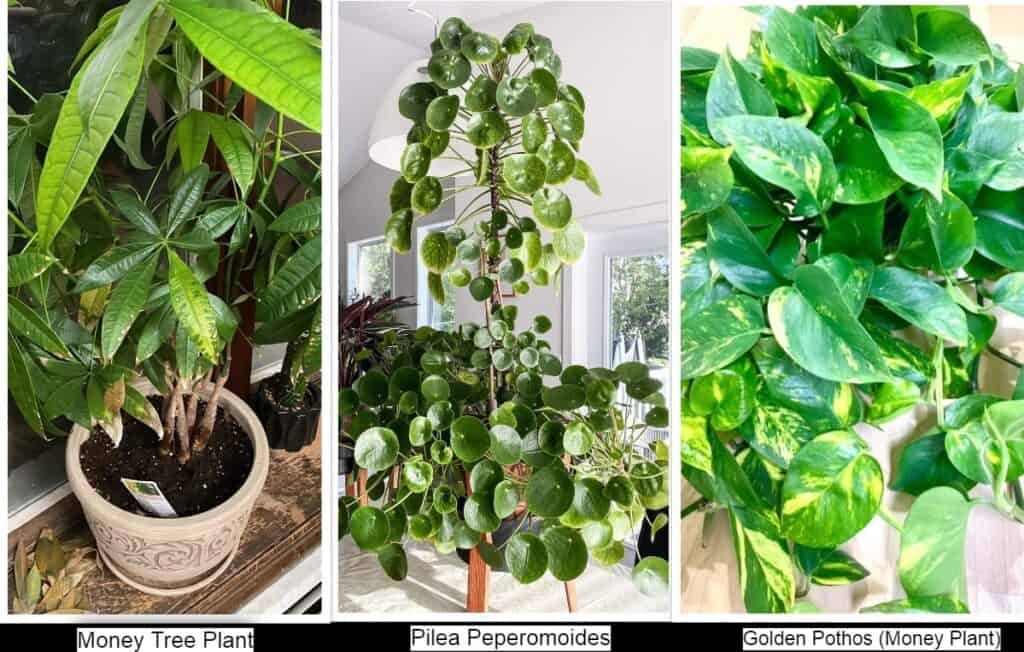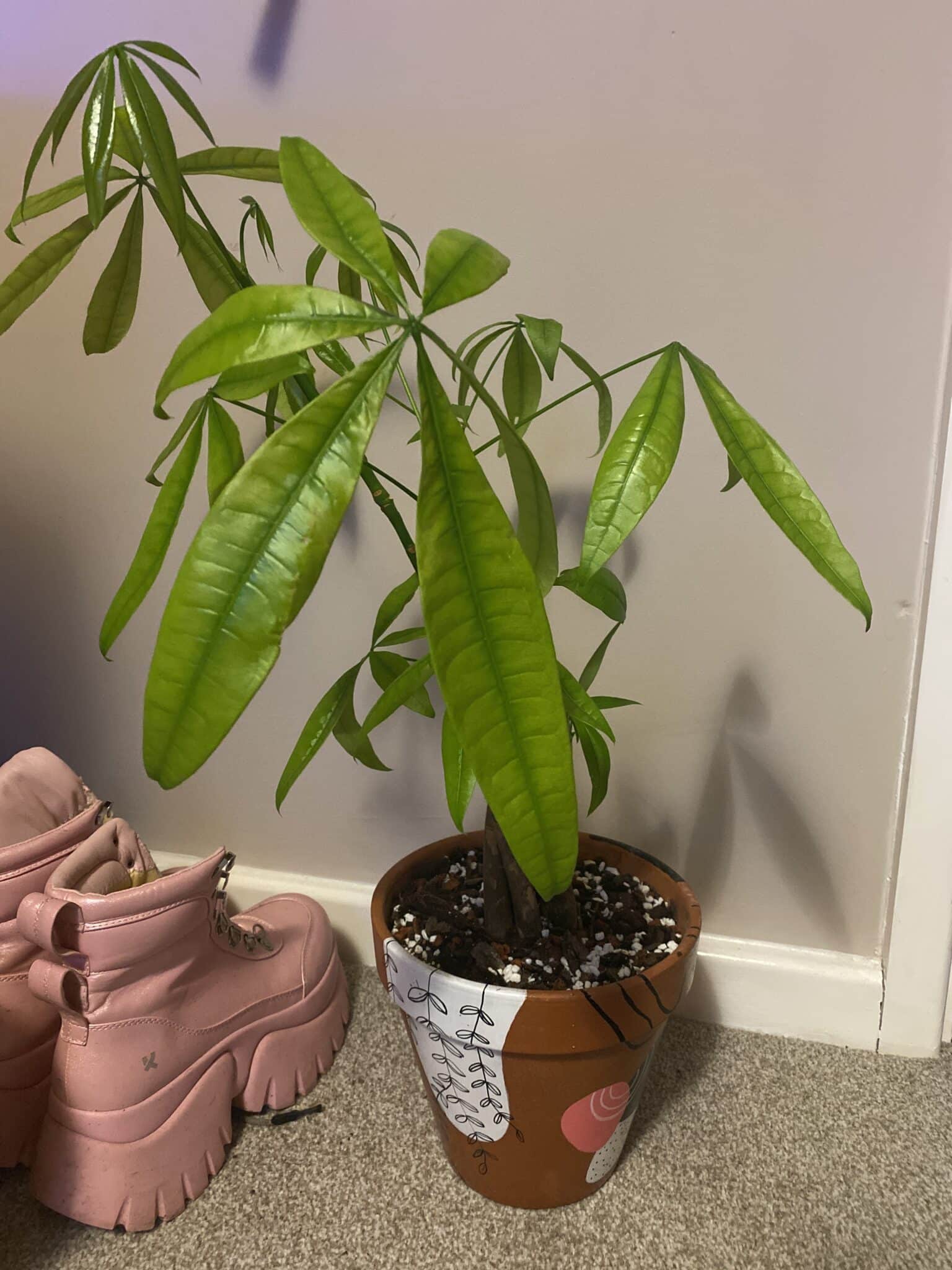Did you know the Money tree you own has fantastic meaning in Feng Shui and symbolizes affluence and nobility to anyone who cares for it?
Read on to find out the symbolic and practical benefits of growing a Money tree and where you can find new healthy plants.
Table of Contents Show
Overview of Money Tree
The broadleaf evergreen Money tree is native to Central and South America, but the first ever ornamental Money tree was cultivated in Taiwan.
Today, exotic plant sellers worldwide are selling the Money tree as a dynamic Feng shui houseplant.
Here is an overview of the Money Tree plant.
| Indicator | Identity |
|---|---|
| Scientific Name | Pachira aquatica |
| Common Name | Malabar chestnut French peanut Guiana chestnut, Provision tree Saba nut Monguba (Brazil) Pumpo (Guatemala) |
| Native | Central and South America |
| Family | Malvaceae |
| USDA Zone | 10-11 |
| Plant Type | Tropical wetland tree |
| Growth Size | 8 feet (indoors) 20-30 feet (outdoors) |
| Grown For | Fen shui properties Health benefits Ornamental leaves Braided stems |
| Foliage Type | Bright green palm looking leaves |
| Leaf size | 5-9 inches long 4-5 inches wide |
| Flowering | Yellowish-white, with curly petals and 3-4" long red-tipped stamens |
| Flowering Season | Summer |
| Fruiting | Football shaped seeds pods reaching 12 inches in length |
| Availability | Sold through exotic plant sellers |
| Toxicity | Non-toxic to cats or dogs |
Although native to the Americas, the Money tree has traveled thousands of miles to Taiwan and East Asian countries as a prized possession and sold for hundreds of dollars.
Money Tree or Money Plant: Confusion Solved!
Many novice gardeners confuse a Money plant with a Money tree plant because both plants signify the same purpose – good fortune.

However, they share some traits as both houseplants grown indoors possess Feng shui benefits.
Most gardeners in South Asia, East Asia, and Southeast Asia highly praise the plant, which may explain why they are often interchangeable.
Here are the fundamental differences between the two favorite houseplants.
| Money Tree | Money Plant (Pothos) |
|---|---|
| Scientific name: Pachira Aquatica | Scientific name: Epipremnum aureum |
| It belongs to a Malvaceae family native to South America | It belongs to Pothos family native to Southeast Asia |
| The indoor grown Money tree is a dwarf species often grown as the ornamental plant | Indoor or outdoors, Money Plant is grown as a vining plant |
| The leaves get up 8-9" long and slender | The leaves retain the signature heartshape and boast size of about 3-5" long |
| Leaves grow in a cluster of 4-8 or more leaves at the stem's end | Leaves will grow evenly throughout the stem |
| Money tree grow in a cluster and may slowly retain their full size. | Money plant is a rapidly growing houseplant and manage to grow few feets within a year. |
Similarly, Jade Plants and Chinese Money Plants like Pothos are often interchangeably used with Money Trees but are distinct plant species.
Money Tree: Meaning, Legend & Symbolism
If you have met a Money Tree admirer, you must have about the folktale surrounding the origin of the plant.
He took it home as an omen and made money selling plants propagated from its seeds.
However, with time, gardeners begin desiring Money trees to decorate their homes and offices, giving rise to its demand.
The elongated leaves, shaped like the Japanese bronze 100 Mon coin from the nineteenth century, give the impression that they represent money.
Feng shui, the famous Chinese geomancy, even adopted the plant as one of the beneficial houseplants.
According to them, the plant positively affects the owner’s life and alters three different afflictions.
The Money tree represents the five Feng Shui elements in balance: wood, water, fire, metal, and earth.
| Benefits | Properties |
|---|---|
| Good Luck | It is often added to home at the beginning of a new year to bring good luck or gifted as a housewarming present. |
| Wealth | It is often grown in offices or southeast areas of the house to attract wealth and fortune. |
| Prosperity | It is placed in the east area of the house to bring good health and prosperity. |
Many growers associate the plant’s sturdy stem and overgrown foliage with strength and power.
Even, Bonsai practitioners take up the challenge of creating miniature Money trees at home to display their patience and concentration.
Spiritual & Traditional Meaning of Money Tree
The Money tree is one of the favorite Feng Shui plants, and most regard the plant as a fortune-bearing oriental houseplant.
Let us delve into the spiritual and folk meaning of Money Tree.
- Good Luck: Many Southeast Asia and China consider it a plant that brings good fortune. Therefore, you must maintain the plant to keep it looking healthy.
- Prosperity: Growers in the East Asian culture often gift it in business and personal affairs as it is believed to enhance prosperity and abundance of wealth.
- Positive Energy: The large, green leaves of the Money tree cleanse air-borne toxins while boosting oxygen contents and releasing positivity.
- Protection: The Money tree plant protects its owner and surrounding areas by annihilating misfortunes, heartbreaks, illnesses, and other accidental dangers.
Money Tree Meaning in Household & Business
Place the plant in the “Money area” of the home or office to bring prosperity and wealth.
Here is how it will fare when you keep them in different locations of your home and office.
1. Money Tree Meaning in Household
You can keep Money Tree at home to bring positive energy, good fortune, and balance.
Feng shui indicates that placing a money tree in your home balances the chi energies governing your finances and luck.
- Place the plant in the southeast of your home to bring wealth.
- When running a home office, place it near the southeast corner of windows to bring in luck.
- Introduce plants in the room of someone sick to help cure them sooner.

2. Meaning in Office or Business
Business owners and executives often exchange Money trees whenever the other party opens a new business, expands its services, or undertakes a new challenge.
Exchanging the plant is an expression of well-wishing for good luck and prosperity and boosts the arrival abundance of wealth and prosperity.
- Retailers or restaurateurs should keep the plant near their shop entrance.
- Those dealing with money should keep the plant close to their cash register.
- Corporations often use Money trees in the lobby or traffic near the entrance or reception.
- When kept in the office, consider placing it in the southeast corner.
- The plant should be located near manufacturing units, accounting departments, or factories.
Money Tree Meaning Based on Numbers of Leaves
The cluster of leaves on the Money tree’s branch differs in number.
The branches may have four or five leaves at most, making a branch with six or more leaves a rarity and considered a sign of great fortune.
| No. of Leaves | Significance |
|---|---|
| 5 Leaves | They represents five elements of balance: earth, fire, water, wind, and metal. |
| 6 Leaves | They are believed to bring luck. |
| 7 Leaves | They are rumored to bring extra luck, such as for lottery. |
| 8 Leaves | They are very rare and priceless. |
Money Tree on Sale
Although Money tree plants are easily found in many nurseries, you may fail to find one with braided branches.
Look at the exotic plant sellers worldwide to find some of the best-looking ornamental Money trees.
| Buying Options | Delivery |
|---|---|
| Etsy | Within 3-5 days |
| Bloomscape | Within 2-5 days |
| Amazon | Within 5-8 days |
| Lively Root | Within 1-2 days (Express) and 4-7 days (Standard) |
To Conclude
Most old folks suggest you maintain your Money Tree plant to pass it down to your children so they can enjoy good fortune and luck.
So better provide your Money Tree with direct and indirect sunlight and rotate it regularly for even light distribution and water them scarcely every three weeks.


